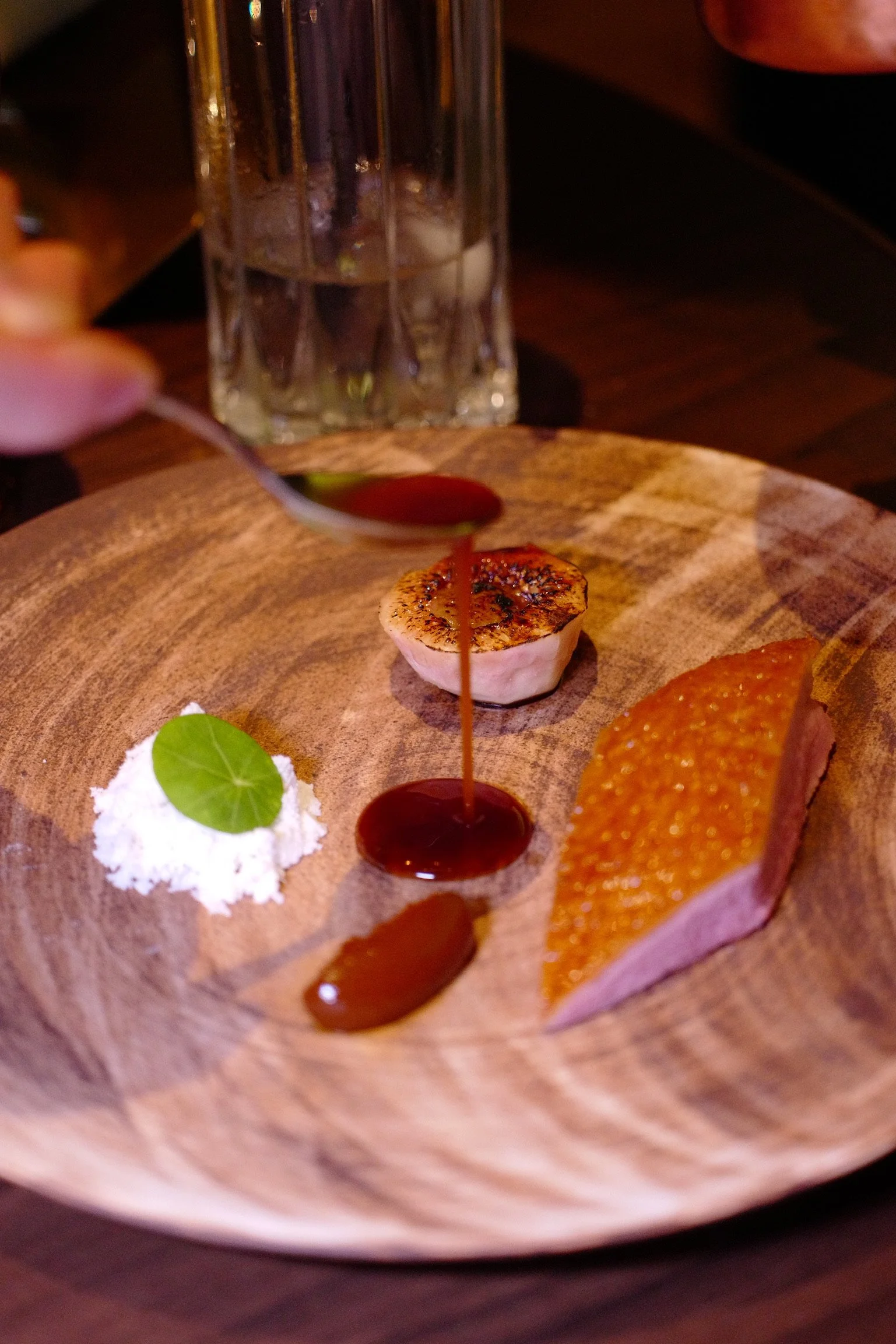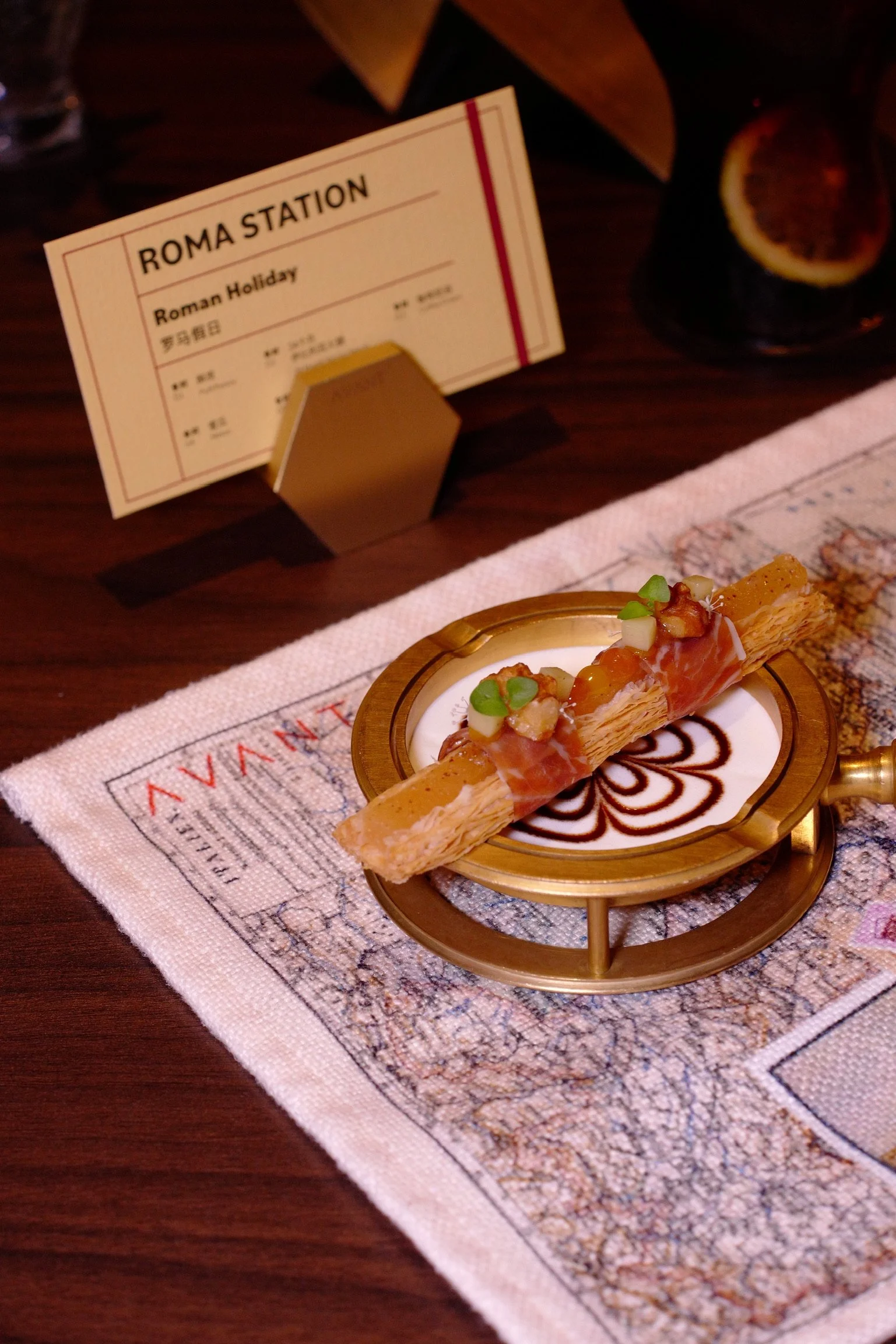Avant
Avant holds a unique position in China's gastronomic scene as a "one-of-a-kind" establishment. While the trend in Beijing and Shanghai leans towards neo-Chinese cuisine and Guangzhou and Chengdu explore modern culinary arts, Avant, tucked away in a corner of Shenzhen (which, personally, I find somewhat out of the way), follows a "global without borders" style based on Western cuisine. Its uniqueness alone makes it a restaurant well worth visiting.
But if you were to ask how it feels to dine there, I would compare it to this:
Avant is like a beautiful woman with autism, armored in beauty, with every detail from her eyelashes to her teeth and jewelry meticulously crafted. You can easily recognize her beauty, but it's hard to penetrate her heart and empathize with her.
Translating this metaphor to the dining experience:
1. The "armored beauty" aspect means many courses with generous portions, each dish accompanied by a design poster explaining the ingredients. There's no complexity, just more complexity (for example, the "Wisdom of the Farmer" vegetable salad involves dozens of cooking methods like tempura, char-grilled, candied, soy pickled, and salt-baked). The research and development philosophy is highly storied, so diners quickly get a sense of "value" or "exquisite taste," akin to the first impression of a beautiful woman.
Of course, the flip side of this "true value" feeling is a somewhat overdone sense of pressure and showing off. Avant isn’t the kind of restaurant that offers a breath of fresh air (like Rêver in Guangzhou or DA VITTORIO SHANGHAI in Shanghai, which I find to be balanced and elegant), but it is definitely bright and knowingly beautiful.
If compared to a girl, it's like knowing she spent two hours getting ready just for your date. If Ensue represents the "high-end restaurant fooling school," then Avant is the opposite of fooling—so sincere that you worry she’s wearing herself out, and you can't help but say, "You’re beautiful even without makeup."
2. The "autism" aspect: You can recognize her beauty effortlessly, but it's hard to connect and empathize with her.
Avant’s entire menu is intensely personal, a collection of Chef’s gustatory memories and artistic creations from his travels (including Thailand’s Chiang Mai, Indonesia’s Bali, Japan’s Toyama Bay, Morocco, Portugal’s Porto, Italy’s Rome and Treviso, Norway, and more). However, for diners, these sporadic, random, and personal flavor collections and transmissions are like a one-way output from the chef. Since these are his memories, not ours, the concepts, though well-thought-out, may lack the "soul-striking" works that resonate with diners.
So, if you were to find a national counterpart for Avant's "personal chef style," it would likely be Obscura by DeAille Tam in Shanghai (unverified speculation, corrections welcome)—Chef Jerry is also presumed to be a self-taught chef with strong personal views and characteristics.
As a pioneering restaurant, I'm more interested in understanding you than just praising your deliciousness.
Rather than one-sided chef outputs, I look forward to more "collaborative creations" with diners at Avant. For this review, here are two suggestions:
1. In general, AVANT's menu seems designed for young adult men. Indeed, getting so much food for 2000 RMB makes one feel the "true value," but the "utility" of the dish is equally important—feeling just right when eating. I skipped lunch that day, but I felt fatigued 70% through the meal, which affected the rest of the tasting experience. From this perspective, could the restaurant consider a mini discovery set, allowing diners to freely combine 8 dishes from the seasonal menu, priced around 1388 RMB or so?
2. Specifically, a common issue seems to be the overly detailed and complex expression of dishes. A lot of elements are piled in, but they are sometimes hard to perceive through a single tasting, and many sauces taste familiar despite the complex descriptions. The menu's descriptions are too lengthy and try to cover so much that they lack focus and can be overwhelming. Of course, what I’ve mentioned as "problems" regarding "portion size" and "style" may be perceived as "truly complex," "awesome," and "truly valuable" by another group of diners. In other words, they are also Avant's way of conveying "exquisiteness" and "attentiveness" from the inside out. Even a small birthday card comes with adorable hand-drawn illustrations and signatures from the entire team, which is probably unmatched in mainland China's restaurant scene.
This "exquisiteness" and "attentiveness" are certainly good, scarce, and give diners a sense of being loved and
noticed; they are sincere expressions. If I were to compare it to a style of porcelain, it would be "famille rose" – sufficiently complex, colorful, and vying for beauty, with a royal court feel. Personally, I prefer the elegance, balance, and simplicity of porcelain styles, like the Jinshu Moonlight plate from Baitu, which is very restrained. So, I appreciate AVANT, but it’s not my favorite.
Here's a brief record of the dishes and dining experience:
The first dish, "Treasures of Toyama," consisted of Toyama Bay white shrimp sashimi and sweet peas in a cylindrical shape, topped with sturgeon caviar and a floral garnish, drizzled with beurre blanc sauce. A flat opener, with a familiar cold umami expression, wasn't particularly creative, although the presentation was beautiful, and starting with caviar made sense. The pickled plum in the sauce was hard to detect, and it was essentially the familiar taste of beurre blanc with a matcha tint.
The second dish, "Exploring Mitsuwa," was the chef's memory from his time in America, frequenting Mitsuwa, a Japanese supermarket chain. The sea bream sashimi was lightly marinated in kelp and paired with sea urchin, drizzled with cucumber juice. It had a subtle summer style, somewhat repetitive of the first dish.
The third dish, "Roman Holiday," a multi-season favorite, indeed provided a stunning holiday vibe. Underneath was a map of Rome, with a thin layer of coffee foam in a pot-like container, topped with a butter pastry roll, wrapped in Spanish ham, and covered with diced melon and warm panna cotta. This dish had a magical relaxing effect, evoking a sunny day in Rome, enjoying breakfast under the shade of a building. The concept was straightforward but clever.
The fourth dish, "Wisdom of the Farmer," was a high-level version of a vegetable salad, showing off with over thirty types of vegetables and fruits, using a myriad of techniques. If such vegetable salads were sold outside, perhaps mothers wouldn't complain about their children not eating vegetables.
The fifth dish, "Hakka Heritage," rode the wave of the popular hake fish, essentially a high-end version of haddock, which I think is largely a result of supplier marketing. The hake was brushed with a tree sap (a Fujian specialty) and wrapped in romaine lettuce for slow-cooking at a low temperature. The sauce was claimed to have a rich Hakka-style lei cha element, but it turned out to be a complexly described but ultimately simple green butter sauce. It was ordinary, at best.
The sixth dish, "Pearls of the Boat People," referring to the water dwellers, first brought to mind the Battle of Chosin Reservoir. Since it's a community on water, the dish mainly featured fish and shellfish. The scallops, similar to tempura, were fried on the outside but still tender on the inside, paired with crab roe and swimmer crab meat. However, the seafood taste felt artificially strong, not very natural.
The seventh dish, "Mong Kok Fireworks," along with the following few dishes, felt like fillers to me. The mantis shrimp were drizzled with Typhoon Shelter sauce, sprinkled with crispy rice, and finger lime. The concept was a bit simple and the elements common; the aromatic essence wasn't there, nor was the temperature sufficient. The taste of Hong Kong's bustling night markets wasn't captured in this dish.
The eighth dish, "Norwegian Forest," was somewhat nonsensical in name—just because dry-aged duck was used doesn’t evoke Norwegian cellars. In common understanding, due to the popularity of American steakhouses, dry-aging is more readily associated with America. "Norwegian Forest" reminds me of the famous Japanese novel and its sense of fragmentation, the "youthful pain," which this dish failed to express. The three sauces included Xiangxi bacon powder, Ancho chili sauce, and roselle sauce.
The ninth dish, "Monsoon Memories," was one of my two favorites (the other being "Roman Holiday"), elevating the complexity of a simple fruit sorbet to the level of a "dish." Based on a red pepper and tomato sorbet, with lychee lemongrass snow frosted by liquid nitrogen at the bottom, complemented with garlic milk foam, sprinkled with fish sauce and black olive crumbs. Thus, the layers of this dish were a primary sourness, accompanied by saltiness, and a touch of sweetness and spice, quite complex and even able to abstractly express the flavor of a tropical island breeze, taking me back to long summers spent in Chiang Mai or Phuket. If "Roman Holiday" was clever, then the beauty of this dish lay in its talent.
The tenth dish, "Spice Utopia," featured
two lamb cutlets, accompanied by harissa sauce, filled with the rugged conflict of North Africa, though the plating could have been more Moroccan.
The eleventh dish, "Porto's Warm Winter," was a warming seafood risotto, dotted with fluorescent squid, hot and savory.
The twelfth dish, "Treviso Christmas Night," recreated the sensation of snowflakes using molecular gastronomy (tasteless but with an accurate texture), flavored with coffee, rum, and hazelnut. An interesting dish, good for a couple of bites but monotonous if more.
The thirteenth dish, "room4dessert," featured pineapple chiffon cake, apple tart, and white chocolate, proving there's always room for dessert.
Avant, China's sole "famille rose" style restaurant, is worth continued attention.









